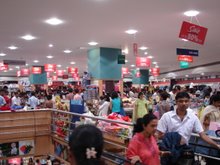Keep your customers happy to stay on growth course

THE MOST striking feature of the Indian car customer is the sheer diversity within this universe. The most auspicious months in the South, when customers literally lap up cars from showrooms, often turn out to be the lean season in the North or the West. Again, while diesel cars are now starting to get more or less popular in many parts of the country, the bulk of diesel car sales have traditionally been cornered by markets as far apart as Andhra and Punjab. Car customers everywhere, even in more homogenous societies in the West, are known to nurture very specific and distinct preferences. Each one prides at being “different”. But in India, the scope and scale of this “difference” is on another plane. On the one hand, we have a set of about 50,000-odd customers in this country who will buy any new car that is launched. Neither price, nor product nor advertising can claim credit for this; the only inducement for their purchase is their urge to get noticed. At the same time, there are many hundred thousand people in the country who can well afford a car, but refuse to buy one. They believe a car does not fit into their lifestyle. For a family that commutes by bus or train, driving and maintaining a car is not worth the hassle. Then there is another section that aspires to have a car, but does not know how to drive. Possibly offering him a decent facility, a driving school, where he can learn driving can help him own his dream car. Some of them are deterred by the glamour and razzmatazz of car showrooms, preferring instead to hand in cash and buy their car at a village fair. From Moga to Gorakhpur to Coimbatore and Burdwan, that is our experience over and over again. This category of affluent non-buyers has to be persuaded, reassured and supported adequately before they decide to buy. Once one member of the community is persuaded, peer effect leads many others to follow. Car finance has, as in other retail areas within the economy, catalysed the boom in car sales. Three out of every four cars sold in the country are funded by a loan. This has obviously brought in many more entry-level customers. But it has catalysed demand in other ways as well: replacement cycles seem to be shortening. Owing to the flurry of new models and availability of attractive car loans, more and more customers are replacing their car within 3-4 years. Car finance is encouraging another trend: the second car in the family. Like with the second TV or multiple music systems, the trend of a second car in the family seems to be catching on. Children are playing a critical role in deciding the model and the colour of the car his father or mother should be driving? Their knowledge influences parent’s decision perceptibly. But even in car finance, the real thing is yet to come. Organised finance has not gone deep enough into semi-urban and rural areas. Banks, especially those in the private realm, still have very many “negative profiles” who are refused loans. Policemen, lawyers, teachers and journalists are left out. Entire localities are excluded. For us, that is a missed opportunity. The car loan industry is not geared yet to offer car loans to well-to-do families in rural areas who may not have a salary statement or a PAN card. But all this is changing quickly. Several finance companies have switched to more flexible systems whereby their field staff uses alternative cues to assess creditworthiness and sanctions loans on the spot. Banks are evolving rural models, backed by innovative structures and relevant technology. That will unleash the demand potential in rural areas. There are other attributes peculiar to the Indian car customer. The reliance on “word of mouth”, for one. The abracadabra of the most creative – and expensive —- ad campaign is no match compared to the opinion of an uncle, a friendly neighbour or even a fellow motorist at a traffic light. The best route, therefore, is to try and keep your existing customers happy. Service their cars well, organise free check-ups for cars, handle insurance claims and repairs with dignity and when customers want to sell off their car, help them do it conveniently for them. That is the smartest marketing tool. The goodwill and positive word of mouth takes you a long way. Offering customised solutions is the need of the hour. The Indian car customer is demanding more and more at the same price, and this behaviour ties in well with the way middleclass India itself has evolved. Young people want the best and latest in terms of global brands and western lifestyles. But they want this without having to give up their traditional values and tastes. So while a car customer desires good looks and the latest technology in her car, none of it can be at the cost of the traditional values of fuel efficiency, reliability, low cost of ownership and quality. The theory of natural transition from small car to luxury segment comes becomes debatable here. Our own experience in car replacement shows that 50% of small car owners are re-buying small cars; they are reluctant to experiment with luxury cars due to high cost of ownership. None of this should suggest that I have figured out the Indian car customer. Far from it. As demand booms, categories and segments blur, preferences become more marked and mature, the latest models roll in, the great Indian car owner continues to startle and bemuse like never before.
Courtesy:EconomicTimes
For more detail on Retail India visit: http://www.retailindia.tv



No comments:
Post a Comment